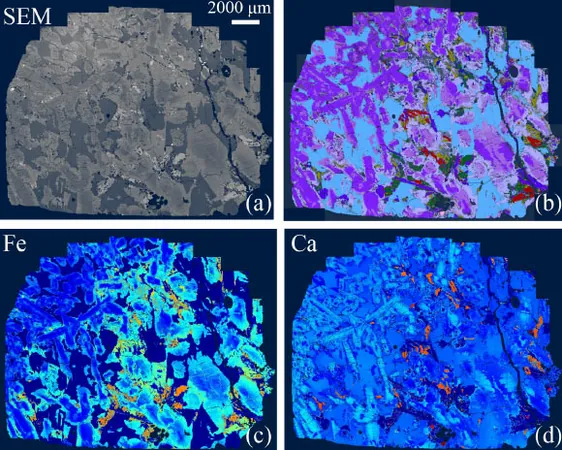
Unveiling Mars: Newly-Discovered Meteorite Could Transform Our Understanding of Volcanic Activity on the Red Planet
2025-07-10
Author: Nur
A Meteorite from the Abyss of Mars
Meet the Martian meteorite Northwest Africa (NWA) 16254— a remarkable 406-gram gabbroic shergottite that was unearthed in Algeria just two years ago. This cosmic rock serves as a direct link to the volcanic history of Mars, giving scientists a unique window into the planet's evolutionary processes.
Unlocking the Secrets of the Martian Mantle
As Dr. Jun-Feng Chen and his team from Chengdu University of Technology explain, Martian meteorites like NWA 16254 are the only samples we have to study the Martian mantle's composition and development. They constitute about 90% of Martian meteorite finds, particularly shergottites, which are essential for understanding mantle dynamics and how Mars has transformed over time.
Variations in Formation: The Four Faces of Shergottites
Shergottites come in diverse forms— from basaltic to gabbroic— which reflect their intricate formation environments. This diversity is pivotal, with gabbroic shergottites preserving textures that reveal their slow cooling in magma chambers beneath Mars's crust.
Decoding NWA 16254's History
Through advanced mineral mapping and geochemical analysis, researchers have begun to decrypt the story of NWA 16254. They've identified distinct geochemical behaviors between the pyroxene cores and rims, shedding light on the dynamics of magma chambers and how magma evolves as it moves.
A Tale of High-Pressure Origins
The team discovered that NWA 16254 originated under intense pressure— between 4.3 and 9.3 kbar— at the boundary between the Martian mantle and crust, where magnesium-rich pyroxenes crystallized. As the magma ascended, it underwent changes that produced iron-enriched pyroxenes and plagioclase.
A Unique Snapshot of Magma Evolution
This meteorite’s coarse-grained texture reveals a slow cooling process, suggesting that it formed from episodic magma extraction from a long-lived and depleted mantle reservoir. This finding is crucial for piecing together Mars's magmatic evolution.
A Revolutionary Perspective on Volcanic History
Notably, NWA 16254 challenges existing theories about Martian volcanic activity. Its low levels of oxygen fugacity imply a history of reduced conditions during crystallization, indicating a potentially heterogeneous mantle that prompts new questions about Mars's redox evolution over eons.
What's Next for Mars Exploration?
Future studies may reveal whether this meteorite points to ancient mantle melting occurring 2.4 billion years ago or more recent magmatic activity—essential insights into Mars's thermal history. As scientists dive deeper into the mysteries of this gabbroic gem, our understanding of the Red Planet continues to evolve.
Discover More in the Journal Planet
These groundbreaking insights were detailed in the research paper by Jun-Feng Chen and colleagues, published on May 13, 2025, in the journal Planet. Stay tuned for more revelations from the Mars exploration saga!





 Brasil (PT)
Brasil (PT)
 Canada (EN)
Canada (EN)
 Chile (ES)
Chile (ES)
 Česko (CS)
Česko (CS)
 대한민국 (KO)
대한민국 (KO)
 España (ES)
España (ES)
 France (FR)
France (FR)
 Hong Kong (EN)
Hong Kong (EN)
 Italia (IT)
Italia (IT)
 日本 (JA)
日本 (JA)
 Magyarország (HU)
Magyarország (HU)
 Norge (NO)
Norge (NO)
 Polska (PL)
Polska (PL)
 Schweiz (DE)
Schweiz (DE)
 Singapore (EN)
Singapore (EN)
 Sverige (SV)
Sverige (SV)
 Suomi (FI)
Suomi (FI)
 Türkiye (TR)
Türkiye (TR)
 الإمارات العربية المتحدة (AR)
الإمارات العربية المتحدة (AR)